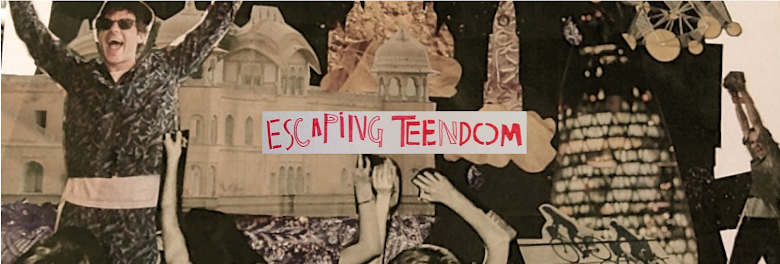In a repetitive cycle of clips 'sampled' from a myriad of high school films, Beyond Clueless opens with a scene we all are familiar with. Opening credits: a walk into the folorn high school, the sun drenched high school, the castle-like high school. The bell rings. A scatter of kids walking through the corridors is shown in another montage.
These kids all have a similar purpose - to survive high school using their individual skills they cultivated in elementary and middle school. Separated by their characteristics and physical attributes, the distinctions between the teens are made clear by the differences in survival tactics.
It is defining moment in each movie when the main characters are seen walking through the locker lined corridor. The viewer analyses their dress, their entourage, their posture and we can determine if they're a jock, a geek, a freak, a plastic, a dweeb, a burn out, or even, - a rare treat: an individual. You can furthermore categorise all of these into two separate groups if you ask the question; do they stand out, or blend in?
The director Charlie Lyne explains...
Charlie: The corridor walk is like the Elizabethan prologue of the teen movie, introducing each of the key players with an incredible degree of emblematic precision.
Right, there’s a certain iconography to it that you don’t fully realize until you see them all together. '
High school movies are traditionally American therefore from a British teen's point of view, the films perhaps are even more reveered as our schools are different so we look on the American high school more objectively. In America, the experiences are familiar, but more brash. The cliques are also similar but more clearly segregated. The confrontation is (eventually/usually) up front. Therefore the ambiguety of British 'senior school' is explained more obviously for the lost british teenager though American high school movies. One's personal angst may be momentarily relieved as one indulges in watching others social strife. One may feel empowered if they see a character or a stereotype they connect with.
It is interesting to find out that the director is in fact 'a 24 year old freelance journalist and filmmaker. He is editor of Ultra Culture, a UK-based movie blog, and home entertainment columnist for The Guardian.' Since he was 13, teen movies accompanied his life, so it is easier to understand where the nostalgic, but critcially analytical perspective derives, from.
Some directors try to use their film to explain the uncomfortable and forced upon, social mess 'as described by the geeks or dweebs'. Other directors may maniuplate the plot to give clarity as to why some girls or boys ascend up the fragile social ladder, as they exploit the fragilities and insecurities of the students 'below'. Beyond Clueless beautifully collates a sort of tessalating pattern through the series of clips. Similarly we could describe it as a kaleidoscope, as the shimmering and hazy shots, captured by the soft tones of 90's video cameras, fall into place and create a dazling repeated image, similar to some of the drug infused sights of many of the characters, in films such as Dazed & Confused or 'Cruel Intensions'.
The film is narrated by Fairuza Balk of 'The Craft'.
With this knowledge, the film automatically is infused with a more cynical stance, as the overlayed words have an air of wisdom, or a warning tone, as people who have seen The Craft know the struggles our character/actor has endured. We learn very quickly that teenage life is painful, despite the facade of beauty that some of the kids uphold, or how sunny California may be. Nevertheless, the stereotypical teen angst and fustration manifests itself so strongly as the teenager grows more self indulgent (not maliciously, just through inevitable circumstances) and believes that their struggles are unique to themselves. Beyond Clueless rejects this notion as we see so many clips of the same motifs. The film becomes this hypnotic, aesthetic daze soundtracked by the (English) band Summer Camp, who's music, if visually imagined, is a summer day vieled in this thin sheet of sugary baby pink and glittered tissue paper.
With clips from more than 200 films from the 90s - 2000s, Beyond Clueless is an editorial artwork. What is impressive, is the climax of destruction that is the 'problem' in a basic story skeleton. The teenage stereotype is self destructive, as we implode in on ourselves through our insecurities, or our actions (dramatised in teen horror films) become extremely harmful to others. Scientifically the teenage years are when hormones are uncontrolled as they try to connect themselves to the correct receptors, and create the basis for adult relationships. Meanwhile, a conflict between desire, restraint and rules arises, and proves problematic.
Also, the risk appraisal is weaker during later teen years, so the consequences are more drastic we we strive to experiment with experiences - walking blindly through this social confusion of school, and even worse/better - parties. The only beacons of hope are in fact double edged. The infamous symbol of American house parties is the red plastic cup, which is bright and attracts our struggling teens to its content for which they find solace; alcohol - reducing our inhibitions to a mear white line on the ground which the teenage dizzily
steps over. However, in order to balance out extreme angst, one needs extreme drinking, for which the consequences are dire, but again extremely common in Beyond Clueless; puking.
The 80s John Hughes teen movie is a cinematic relic, the 90s introduced darker themes, and harder characters, but the 2000s made them blasé. The evolution of the teen movie carries on in the 2010s, to films like the 'Bling Ring (2013)' where our culture is banale and naive. However, this essay movie on the subject is excellent and knowlegable viewers can rummage through the motifs to see many films they have seen, and have yet to find.



